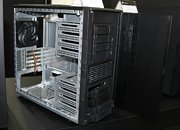Tuesday, June 2nd 2015

SilverStone CS380 Lets You Combine a Gaming PC with a Home NAS
Want a compact gaming PC that doubles up as a home storage? The CS380 "Compact Storage" case could be worth checking out. This micro-ATX case features an aluminium door (with noise-dampening material), steel frame, and ABS front panel bits. Behind the door are eight 3.5-inch drive caddies, with SATA backplanes, which let you hot-swap drives; and a standard 5.25-inch drive bay. Apart from the eight 3.5-inch caddies, the case has two internal 2.5-inch drive bays (for OS drives).
The eight 3.5-inch caddies are split between two drive cages of four; which are separated by room meant for long graphics cards. Its ventilation includes two 92 mm front intakes (located in the space between the drive cages); two 120 mm side vents, two 120 mm top vents (which can hold on to a 240 mm radiator); and a 120 mm rear exhaust. The case measures 212 mm x 435 mm x 444 mm (WxHxD).
The eight 3.5-inch caddies are split between two drive cages of four; which are separated by room meant for long graphics cards. Its ventilation includes two 92 mm front intakes (located in the space between the drive cages); two 120 mm side vents, two 120 mm top vents (which can hold on to a 240 mm radiator); and a 120 mm rear exhaust. The case measures 212 mm x 435 mm x 444 mm (WxHxD).


10 Comments on SilverStone CS380 Lets You Combine a Gaming PC with a Home NAS
It would be better if they would made totally modular case in which you could choose how much space you will use for HDDs or for graphic card, you could fit in about 12 drives instead of just 8, if you would not use it as a gaming system and not use ODD.
There are only 2 power connectors per backplane though, at least that is distributed, but not sure if you need both with 4 drives or how its wired up, see the decoupling Capacitors there (hope they are decent brand).
How does painting the interior affect the EM profile of the case?
Building a NAS so can't wait to get my hands on one of these and check it out.
-these backplanes are very weird and usually one input means more outputs, the speed of SATA's 6 Gbps is divided between drives, but HDDs are not as fast as SSDs
-it is easier to replace your own backplane and probably even cheaper than replacing this backplane that comes with this case
-you can get motherboard with 8 SATA ports which means that if you will not need more than 8 drives you will not even need backplanes and if you do you can buy additonal PCIe-SATA card or 1 backplane
I would use this motherboard for NAS:
www.newegg.com/Product/Product.aspx?Item=N82E16813130851
It has 8 SATA ports and it costs only 73$.
I found a very clear picture of the front side of the backplane that shows the second SAS port pins routing to the second SATA port on the very similar DS380. If you have dual-port SAS drives, you have the option, otherwise, ignore it :)
Why an AMD board won't be good for a FreeNAS system: need ECC RAM, and loads of RAM, a mATX x99 board with Xeon and 32+GB RAM, 10Gb NIC, HBA adapter, will be more suited for that purpose.
On the subject of performance :Yup. If you only have very light usage (<10 clients), you can get away with a lot less. Of course, some slowdowns during writes will probably be apparent, but it's a home NAS... how much do you write?Affects mostly writes. if you have very low writes (like in the case of a home NAS), you can ignore that - remember, a lot of the FreeNAS folks are building SANs for stuff like VM storage or centralised network storage for office.Shouldn't be an issue for harddrives (it's not like a phone's USB port where you plug in every day for charging...) They're usually designed for 100-200 mating cycles, which is plenty for a hotswap bay. Being simple side-locking plastic trays on the other hand is the iffier part... pulling a drive will wiggle it a bit (something you don't generally want to do), but then again, the only time you'd pull a drive is to swap a failing/decomissioned disk, so it's less of an issue than one would expect.
EDIT: If you want to do it real cheap and still have shittons of power (like I am), an old Dual 6-core Westmere server combined with am external HBA and enclosure is the best option. My DL380G6 already has dual X5675 (3.06GHz 6-core) CPUs and 48GB of RAM, next is to add an HBA and enclosure to NAS things up. It runs ESXi, so I can be scrimpy with FreeBSD (I plan to run mine straight with commandline management, none of that WebUI trash) and give it very little RAM (where 8GiB is very little...) and go from there. No dedup for me.. I'm usually very good with that...